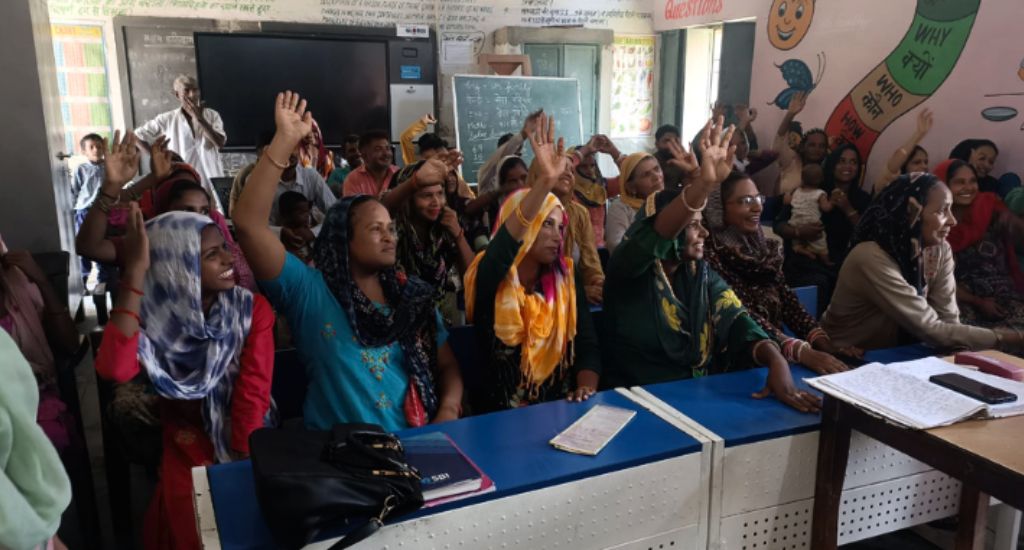
Community leads the way for better schooling in Haryana
Haryana reconstitutes school management committees involving parents, teachers, students and local government representatives to ensure a participatory and inclusive education system.

Haryana reconstitutes school management committees involving parents, teachers, students and local government representatives to ensure a participatory and inclusive education system.
Public institutions are often built on collective action, and it holds true for education as well. That is why Section 21 of the Right to Education (RTE) Act mandates the constitution of school management committees (SMCs) in government schools. SMC is a platform where parents, teachers, students and local government representatives come together to iron out issues and work for the welfare of the school.
Working in this direction, the Haryana School Shiksha Pariyojna Parishad (HSSPP), along with Samarthya – a development organisation working in the education sector – introduced sanjhi sabha in July 2023 to uphold the representative, inclusive and participatory nature of SMCs.
“SMC formation is the first step towards identifying the right people who can give their time to the school,” said Sanjay Kumar, a consultant at HSSPP.
To ensure the required participation, the teams focussed on creating awareness about the formation of school management committees.
“We renamed the SMC formation as sanjhi sabha since it denotes a sense of collaboration. It means that the parents, teaches and the sarpanch can sit and talk about activities in their children’s school,” said Sonali Vohra, project coordinator (science) at HSSPP.
“They can see what is going well and what can be done in a better manner. It gives an opportunity for parents, teachers and the sarpanch to sit together and discuss the issues,” Vohra added.
Watch: Right to education: Where there is a wall, there is a way
To promote inclusion and make parental participation a priority, a quorum was mandated. It requires the presence of parents of at least 50 percent of the students enrolled in the school or at least 100 parents (whichever is less) on the day of the sanjhi sabha.

“In every school, we have seen many parents turn up. Women also participate in huge numbers. Members are decided by consensus,” said Sanjay Kumar.
Instead of adopting a ‘one-size-fits-all’ approach, this decentralisation in decision-making has been a huge enabler in increasing parental participation.
“The SMC’s responsibilities include preparing a school development plan, overseeing how the school grants are used and monitoring the academic activities. Parents are involved in the SMC so that they can monitor the growth of the students,” said Anshaj Singh, state project director, HSSPP.
SMCs have been formed in more than 14,000 government schools across Haryana.
To ensure clarity of roles of the stakeholders and to build their capacity, the administrative officials at all levels were trained. Senior administrators conducted training sessions for officials working with them, thus building ownership for their work. The officials support, monitor and appreciate schools during the meeting.
The guidelines also mandate the government officials in the cluster to be a part of the SMC in an advisory capacity. This enables them to support the panel members in putting forward their opinions and share best practices among the schools they monitor and support. The department has also launched an exclusive SMC portal to give administrators an overview of the committees in their jurisdiction.
The world has witnessed the rise and fall of many institutions where the reliance on a key person was too high. Such dependence on a particular person (in the case of a school, often the school head or a teacher) is not sustainable, participatory or inclusive.
Also Read: ‘Education should make people capable of helping others’

Collective leadership means that multiple stakeholders are aware of, committed to, and invested in their role to chart the way forward. It means fostering a culture of collaboration and collective action. Hence, capacity-building, monitoring and support are processes of prime importance.
Research suggests that genuine partnerships contribute to the planning, implementation, management and evaluation of basic education programmes. By ensuring a strong SMC constitution process that emphasises the power of a collective, the seeds for a well-functioning ecosystem across the state have been sown.
The same guiding principles can be applied to other public systems. These principles include the involvement of officials at all administrative levels, decentralisation of tasks and decision-making, and a strong emphasis on the promotion of public participation. Education is, and should continue to be a shared social responsibility between governmental entities, families, local communities and non-governmental organisations.
“It is our hope that the actions of the Haryana government give strength to the working of schools and the overall growth of students,” said Anshaj Singh.
To effect long-term, sustainable systemic change, we must shift from individual dependence to collective leadership; from siloed, centralised decision-making to transparent, consultative processes; and from citizens passively watching to actively participating.
Also Read: Accessible education for deprived rural students
The lead image at the top shows a school management committee formation process in progress. (Photo courtesy Samarthya)
Ketika Nirula, Sahil Babbar and Deeksha Sudhindra work with Samarthya.